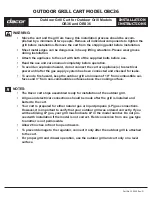
Recommended Focusing Screens
Various interchangeable focusing screens are available for Nikon cameras to suit any type of lens or picture-taking situation. Those which are recommended for use with your lens
are listed below:
Presetting focus range
In cases when you want to shoot within a specified distance range, you can reduce focusing time by setting the focus limit switch from FULL
position to LIMIT. (There are two focusing limit zones; approx. 0.7m (2-1/4 ft.) to infinity for normal shooting, approx. 0.7m (2-1/4 ft) to 0.5m (1-5/6 ft.) for shooting at a close
distance.)
Focusing at a predetermined reproduction ratio
The reproduction ratio is the relation between the size of the image recorded on film and the actual subject size. If, for
example, the image on the focusing screen is one-fifth the actual subject size, the reproduction ratio is 1: 5. To photograph at a predetermined reproduction ratio, use the
following procedure:
1. Manually turn the focus ring until the desired reproduction scale number is aligned with the distance index. 2. Aim at the subject, then change your position, moving closer
to or farther away from the subject, until the image in the viewfinder sharpens. To obtain the appropriate reproduction ratio for each focal distance, see the table below:
Photographic Range with Close-up Attachment
Close-up attachment lens No. 5T, Close-up attachment lens Ho. 6T, PK-series Rings
Depth of Field
The depth of field indicator lines are engraved beside the distance index line. At close distances, however, so lisle is in focus that it may be more useful to
check the depth of field table (on the reverse side of this sheet). If your camera has a depth of field preview button or depth of field preview lever, you can check the depth of
field in the viewfinder.
Minimum Aperture Lock
(Illus. A) For programmed auto or shutter-priority auto exposure shooting, use the minimum aperture lock lever to lock the lens aperture at
f/32.
Notes on Close-up Photography and Duplication Work Camera shake
: The AF Micro-Nikkor ED 200mm f4 D IF provides such exceptionally high image magnification
that even the slightest movement during shooting causes a blurred image. Be sure to mount the camera on a tripod and use a cable release or remote cord to release the
shutter.
Close working distances
At the high reproduction ratios used in close-up shooting, the depth of field is very shallow. To ensure greater depth of field, stop down
the lens, then carefully position the camera to ensure the most important surface of the subject is in the same zone of sharp focus.
Exposure measurement with close-up
attachments
For a lens in normal position, see the following table. For a reverse-position lens, be sure to use stop-down measurement.
Warning
: The F-401s/N4004s*** exposure metering system
will not
work with PK-11A, PK-12, PK-13 or bellows.
*
For stop-down exposure metering, refer your camera 's Instruction manual.
**
Lens modification required After mounting modified lens, manually perform maximum aperture Indexing.
***
The Nikon N90s, N90, N70, N8008, N8008s and N4004s are sold exclusively in the US market;
****
The Nikon N2000 is sold exclusively in the US and Canadian markets.
Model/Screens
EC-B
A/L
B
C
D
E
G1
G2
G3
G4
H1
H2
H3
H4
J
K
P
M
R
T
U
F
F5 + DP-30
(+0.5)
(+0.5)
F5 + DA-30
(+0.5)
(+0.5)
(+0.5)
(+0.5)
(-1.0)
(+0.5
F4+DP-20
(-1.0)
F4 + DA-20
(-1.0)
F3
FE, FE2, FM2, FM2n, FA
Excellent focusing
Acceptable focusing; Slight vignetting or moire phenomenon affects screen image, but film image shows no traces of these.
Not Applicable with screen type. Type M can be used for both macrophotography at 1:1 reproduction ratio and for
photomicrography It has different application than other screens. Type K (K2), E (E2) and B (B2) for FM2, FM2n (And other FM2
series models); FE, FA and FE2,
refer to this section for more info on compatibility issue on exposure compensation.
Indicates degree of exposure compensation needed for F5-series or F4-series cameras (Center-Weighted metering only). For
F5 camera, compensate using the Custom Setting #18 on the camera body. See instruction manual of the camera body for
more details. For F4-series cameras, compensate using the Exposure Compensation Dial for the focusing screen. (See the
F4/F4s instruction manual, page 78). Blank box means not applicable. Since type-M screen can be used for both
macrophotography at a 1:1 magnification ratio and for photomicrography, it has different applications than other screens. For
the K2, B2 and E2 focusing screens, refer to the columns on the K, B and E screens, respectively. For details, also refer to the
specific camera's instruction manual.
Click on table
to
download a copy
for your future
reference
(
PDF Format
73K
)
PN-Ring
Bellows PB-4 or PB-S
Bellows PB-6
Extension Bellows PB-6E
Reprocopy Outfit PF-2, 3, 4
1. Set the lens to its minimum aperture (f/32).
2. Slide the lock lever in the direction of the aperture ring so the white dot on the lever aligns with
the orange dot.
To release
the lock, slide the lever in reverse direction.
Camera Models
Accessories
Exposure measurement
F90x/N90s ***, F90-Series/N90s
***
, F70-Series/N70s
***
, F4 series, F-801/N8008s
***
, F-
801s/N8008s
***
); (
CPU-AI
); F3 series, FE, FM, EL2, Nikkormat FT3, F2 Photomic A, F2 Photomic
AS (AI)
PK-11A, 12, 13/PN-
11
Full Aperture
PK-2, 3/PN-
1/Bellows
Stopped Down
*
F 501/N2020, FE2, FA, FM2, FG,
FG-20, EM, F-301/N2000s**** (Al)
PK-11A, 12,13/PN-
11
Full Aperture or light
intensity feedback
PK-2, 3/PN-
1/Bellows
Stopped Down
*
Non-AI bodies
PK-11A, 12, 13/PN-
11/Bellows
Stopped Down
*
PK-2, 3/PN-1
Full Aperture
**
Seite 2 von 3
AF Nikkor 200mm f/4D ED-IF Lens - Instruction Manual
05.01.2010
http://www.mir.com.my/rb/photography/companies/nikon/nikkoresources/AFNikkor/af200...





















